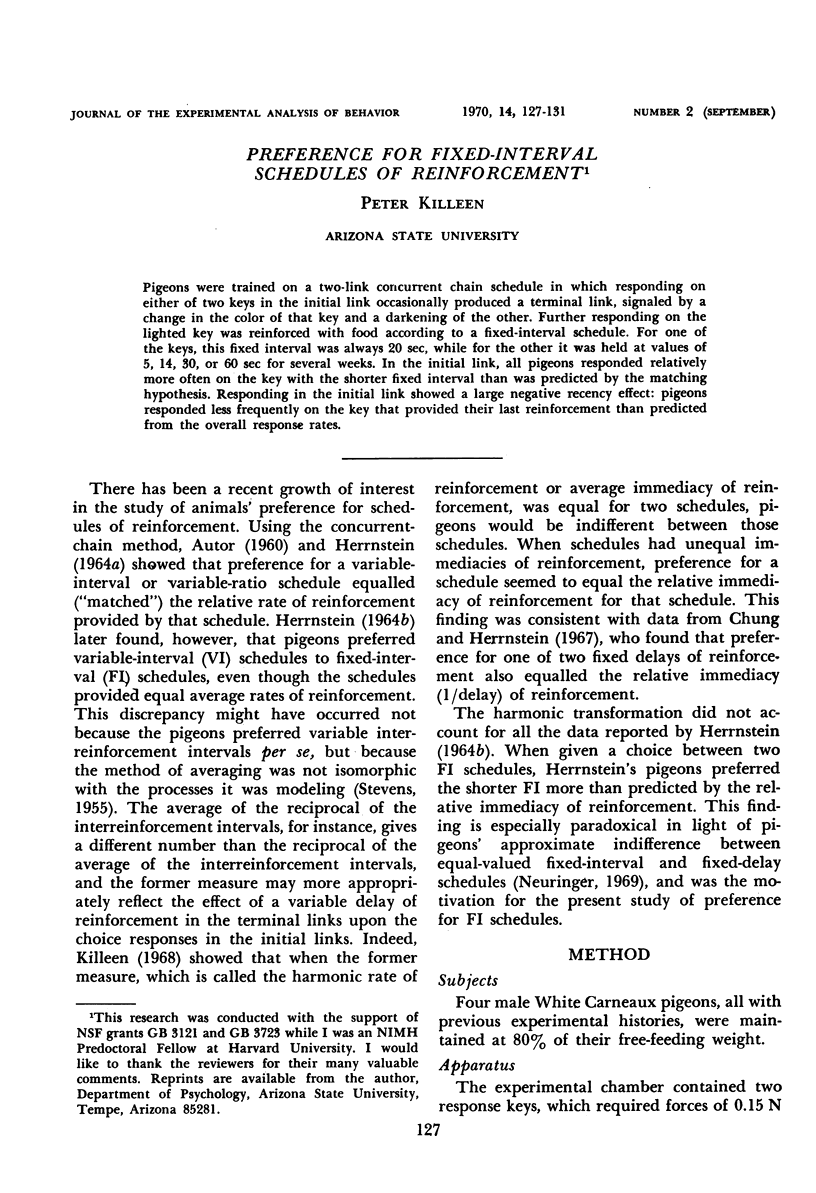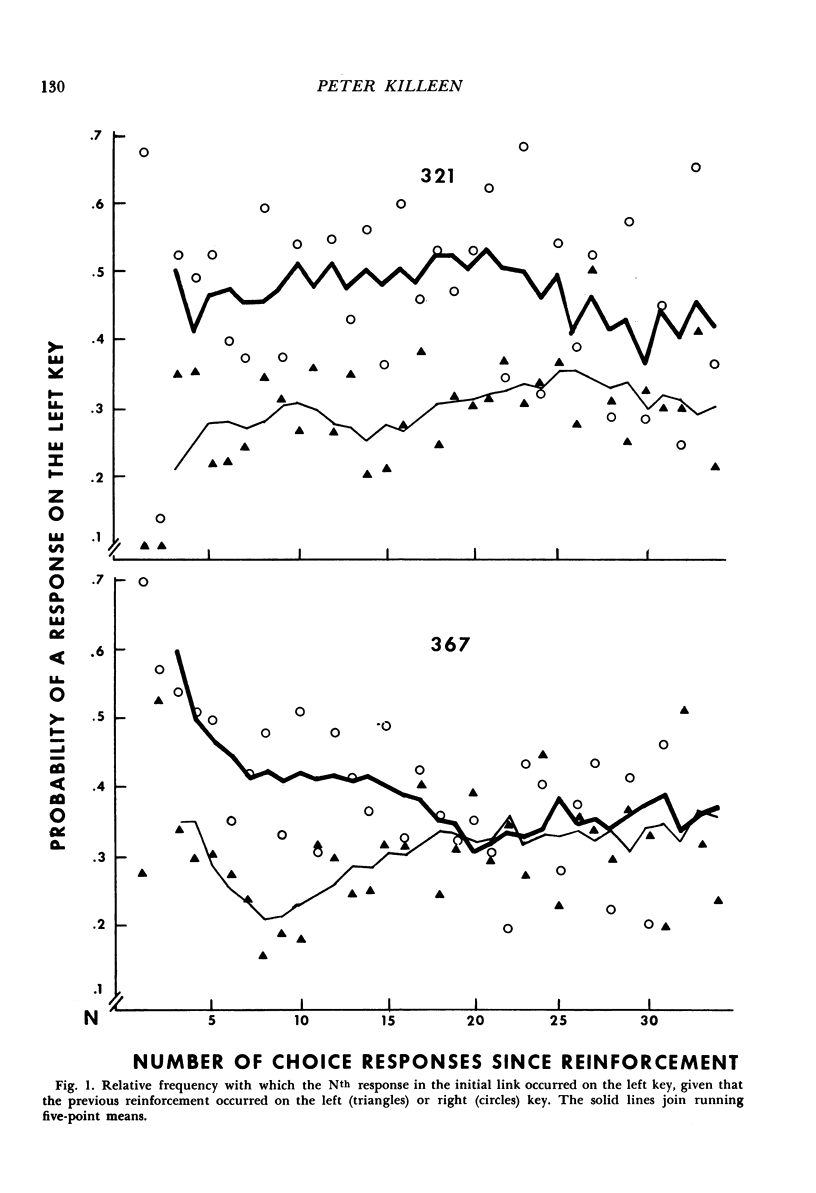Abstract
Pigeons were trained on a two-link concurrent chain schedule in which responding on either of two keys in the initial link occasionally produced a terminal link, signaled by a change in the color of that key and a darkening of the other. Further responding on the lighted key was reinforced with food according to a fixed-interval schedule. For one of the keys, this fixed interval was always 20 sec, while for the other it was held at values of 5, 14, 30, or 60 sec for several weeks. In the initial link, all pigeons responded relatively more often on the key with the shorter fixed interval than was predicted by the matching hypothesis. Responding in the initial link showed a large negative recency effect: pigeons responded less frequently on the key that provided their last reinforcement than predicted from the overall response rates.
Full text
PDF




Selected References
These references are in PubMed. This may not be the complete list of references from this article.
- Chung S. H., Herrnstein R. J. Choice and delay of reinforcement. J Exp Anal Behav. 1967 Jan;10(1):67–74. doi: 10.1901/jeab.1967.10-67. [DOI] [PMC free article] [PubMed] [Google Scholar]
- Davison M. C. Preference for mixed-interval versus fixed-interval schedules. J Exp Anal Behav. 1969 Mar;12(2):247–252. doi: 10.1901/jeab.1969.12-247. [DOI] [PMC free article] [PubMed] [Google Scholar]
- Fantino E. Choice and rate of reinforcement. J Exp Anal Behav. 1969 Sep;12(5):723–730. doi: 10.1901/jeab.1969.12-723. [DOI] [PMC free article] [PubMed] [Google Scholar]
- Killeen P. On the measurement of reinforcement frequency in the study of preference. J Exp Anal Behav. 1968 May;11(3):263–269. doi: 10.1901/jeab.1968.11-263. [DOI] [PMC free article] [PubMed] [Google Scholar]
- MILLER G. A., FRICK F. C. Statistical behavioristics and sequences of responses. Psychol Rev. 1949 Nov;56(6):311–324. doi: 10.1037/h0060413. [DOI] [PubMed] [Google Scholar]
- NEWMAN E. B., GERSTMAN L. J. A new method for analyzing printed English. J Exp Psychol. 1952 Aug;44(2):114–125. doi: 10.1037/h0055693. [DOI] [PubMed] [Google Scholar]
- Neuringer A. J. Delayed reinforcement versus reinforcement after a fixed interval. J Exp Anal Behav. 1969 May;12(3):375–383. doi: 10.1901/jeab.1969.12-375. [DOI] [PMC free article] [PubMed] [Google Scholar]
- Nevin J. A. Interval reinforcement of choice behavior in discrete trials. J Exp Anal Behav. 1969 Nov;12(6):875–885. doi: 10.1901/jeab.1969.12-875. [DOI] [PMC free article] [PubMed] [Google Scholar]
- STEVENS S. S. On the averaging of data. Science. 1955 Jan 28;121(3135):113–116. doi: 10.1126/science.121.3135.113. [DOI] [PubMed] [Google Scholar]
- Schwartz B. Effects of reinforcement magnitude on pigeons' preference for different fixed-ratio schedules of reinforcement. J Exp Anal Behav. 1969 Mar;12(2):253–259. doi: 10.1901/jeab.1969.12-253. [DOI] [PMC free article] [PubMed] [Google Scholar]
- Shimp C. P. Probabilistically reinforced choice behavior in pigeons. J Exp Anal Behav. 1966 Jul;9(4):443–455. doi: 10.1901/jeab.1966.9-443. [DOI] [PMC free article] [PubMed] [Google Scholar]
- Shull R. L., Pliskoff S. S. Changeover delay and concurrent schedules: some effects on relative performance measures. J Exp Anal Behav. 1967 Nov;10(6):517–527. doi: 10.1901/jeab.1967.10-517. [DOI] [PMC free article] [PubMed] [Google Scholar]
- Stubbs D. A., Pliskoff S. S. Concurrent responding with fixed relative rate of reinforcement. J Exp Anal Behav. 1969 Nov;12(6):887–895. doi: 10.1901/jeab.1969.12-887. [DOI] [PMC free article] [PubMed] [Google Scholar]


